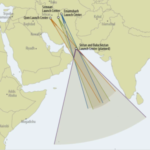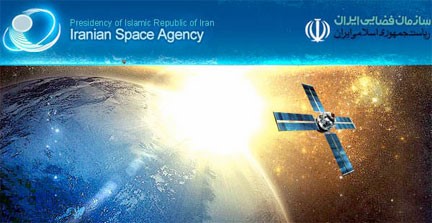“Iran appears to be preparing another satellite launch after twice failing this year to put one in orbit, despite U.S. accusations that the Islamic Republic’s program helps it develop ballistic missiles.” ~ Jon Gambrell, Associated Press, August 18, 2019
Click here for Gambrell’s Stars and Stripes article that begins by noting that satellite images of the Imam Khomeini Space Center in Iran’s Semnan province this month show increased activity at the site, as heightened tensions persist between Washington and Tehran over its collapsing nuclear deal with world powers and as President Trump’s economic sanctions take their toll on Iran.
Gambrell also quotes an Iranian official as saying a satellite would soon be handed over to the country’s Defense Ministry, suggesting that the attempt is imminent — as also suggested by researchers at the Middlebury Institute of International Studies in Monterey, California based on their analysis of “pictures” they had seen.
Based on satellite images of Iran’s space center some 150 miles southeast of Tehran, CNN’s suggestions of Iranian satellite launches before the end of the year — and reports from Iran’s Information and Communications Technology Minister, at least three satellite launches are planned his year: two for remote-sensing and another for communications.
Notably, the next launch comes after two failed attempts at getting satellites into orbit in January and February of this year.
So, what else is new?
Whatever its recent failures, Iran sent several short-lived satellites into orbit over the past decade, and in 2013 launched a monkey into space. Is Iran just getting its earlier efforts back on a more successful track? Or is there a more specific purpose?
Click here for my April 23, 2013 High Frontier message “Monkey Business — Shut the Back Door,” which reported on that early successful launch and its implication, given its reported 4400 pound weight (a considerably greater payload than needed to deliver several nuclear weapons). This event could have been a prelude for launching nuclear weapons (rather than monkeys) especially to be detonated while passing over the United States from our mostly undefended South to produce an electromagnetic pulse (EMP) that could shut down our electric power grid for an indefinite time — actually an existential threat to all Americans.
Of course, the press indicated great concern that this launch in 2013 demonstrated Iran’s capability to launch an intercontinental ballistic missile (ICBM) to attack the United States “once Iran gains a nuclear weapon” — a condition that may already exist as discussed below.
This concern validated congressional directions to the Obama administration, over six years ago, to consider additional ways to defend the Eastern seaboard from Iranian ICBMs that would approach the U.S. from over the North Pole — to strengthen the limited capability of our missile defenses based in Alaska for such scenarios.
As best I know, this concern still has not been addressed. Moreover, there has been little apparent effort to defend against the threat Iran could pose by launching a satellite carrying a nuclear weapon over the South Pole, to attack the United States from the South.
The U.S. alleges that previous and apparently planned Iranian launches defy a U.N. Security Council resolution calling on Iran to undertake no activity related to ballistic missiles capable of delivering nuclear weapons. This pending satellite launches will provide an undeniable prelude to gaining such a nuclear weapon delivery capability.
Unsurprisingly, Iran has long said it doesn’t seek nuclear weapons, and has claimed to maintains its satellite launches without a military component. And Tehran also has also said it wouldn’t violate the U.N. resolution in any case, as it only “called upon” Tehran not to conduct such tests.
These tests take on additional potential importance since President Trump withdrew the U.S. from Iran’s terrible nuclear deal over a year ago — and imposed sanctions, including on Iran’s oil industry, that have had significant debilitating economic consequences for Iran.
Click here for my July 20, 2015 National Review article on what I called “An Iran Deal Distraction” from Iran’s steady, deliberate progress toward achieving a major nuclear threat to the American homeland, including to exploit an existential EMP threat. It also recounts Iran’s earlier satellite tests as discussed above.
In any case, there is a general lack of public understanding about this important existential threat from Iran and on its close alliance with North Korea’s related development and testing activities that also underpin the growing threat from a nuclear-armed Iran. Click here for a February 12, 2016 National Review article, where I joined several well informed former senior officials in elaborating this concern, “Underestimating Nuclear Missile Threats from North Korea and Iran.”
We emphasized that Iran even then (over three years ago) probably had nuclear warheads for its already tested medium-range missiles that actually compose the largest medium-range ballistic-missile force in the Middle East. We noted that Iran could be building a nuclear-capable missile force, partly hidden in tunnels, as suggested by a dramatic revelation of a vast underground missile-basing system in 2015.
We noted Iran is building toward a large, deployable, survivable, war-fighting missile force — to which nuclear weapons can be swiftly added as they are manufactured — and at a time of its choosing could launch a surprise EMP attack against the United States by satellite, especially with help from North Korea.
These matters all should be on the table as President Trump considers his continuing “Art of the Deal” activities.
Notably both North Korea and Iran launch their satellites Southward — so they pass over the United State from our South, whereas most of our ballistic missile defense (BMD) systems have been deployed to defend the United States from ballistic missiles that approach the United States from our North.
So, Iran is nearing additional satellite launches, which indeed could be a surrogate for developing an intercontinental ballistic missile (ICBM) as most observers surmise it to be.
But there is a more ominous possibility — in launching a satellite to its South, Iran could be practicing to carry a nuclear weapon on a southern trajectory over the South Polar region to attack the United States from our South. Moreover, Iran’s missile and nuclear weapon development programs should be considered in concert with those of their ally, North Korea., which also has a record of launching satellites over the South Polar region.
To emphasize again that there is little new in the recent events, I urge you to click here for Bill Gertz excellent February 18, 2016 Washington Free Beacon article that reported on the then, “Pending Iranian Space Launch Contrary to U.N. Resolution.”
A paraphrase of several of Gertz’s pertinent observations over three years ago follow. (My supplementary comments are updated, italicized and underlined.)
- UN Security Council Resolution 2231, which outlines implementation of the Iranian nuclear agreement, prohibits Iran from conducting nuclear ballistic missile tests for the next eight years. Is anyone surprised that Iran again was acting contrary to President Obama’s lousy deal that released over a hundred billion dollars to Iran, which could be used to purchase, among other things, nuclear weapons from its ally North Korea?
- If, more likely when—like now?, Iran (again) violates these commitments, Obama officials have indicated that “we will continue to work with our partners, and take any necessary unilateral actions, to counter ongoing threats from Iran’s ballistic missile program.” Right . . . whatever that meant.
- Contrary to Iranian government statements that its Simorgh space launcher is limited to carrying a 220-pound payload —“too small for a first-generation nuclear warhead,” a U.S. official said the rocket will be powerful enough to carry a large nuclear warhead if Iran develops one. Comment: Low-yield H-Bomb EMP-Super Weapons might well weigh about 220 pounds or even less — and anyway there’s the above mentioned 4400-pound habitat for the monkey astronaut.
- Since September 2016, Intelligence agencies have detected two missile component shipments from Pyongyang to Iran, apparently large-diameter engines — heralding a launch capability for a much larger payload. But Iran launched a monkey into space in a capsule weighting over two tons — in 2013.
- Given that space launch technology is identical to long-range missile technology, U.S. Strategic Command described North Korea’s February 7th alleged satellite test as a test of a long-range missile. Possibly, but a long-range missile might not be what Iran has as a near-term plan.
- As Gertz correctly observes, a satellite-borne nuclear warhead “could be detonated in low-earth orbit to create a damaging electromagnetic pulse [EMP] over wide areas”. . . as Gertz implied, that warhead delivery system would not need to “survive the high heat of atmospheric reentry,” simplifying and shortening its development.
It seems obvious to me that long ago the “powers that be” should have taken note of the fact that Iran’s satellites, like North Korea’s, are launched to the South and approach the United States from over the South Polar regions.
To the best of my knowledge, our “homeland” ballistic missile defense (BMD) systems are designed to intercept ICBMs that approach the United States from over the North Polar regions — In effect, we have left the back door open while attempting to lock the front door.
It is long past time to rectify this misjudgment. Both North Korea and Iran could have demonstrated a capability to attack us from the South with what we called during the Cold War a Fractional Orbital Bombardment System, or a “FOBS” first deployed by the Soviet Union in the 1960s.
If we don’t respond, we will be vulnerable to blackmail if not a direct EMP attack that attack strategy could take down the electric grid with disastrous consequences — as I have written often.
Finally, it should not be forgotten that even short or medium range ballistic missiles could be launched from vessels off our coasts — and to the best of my knowledge, we needlessly remain vulnerable to such attacks, especially from the Gulf of Mexico.
Wake up, America! And what about the “Art of the Deal?”
Bottom Lines.
What goes around, comes around!
So, Iran is planning to launch satellites again — to its South so that they approach the United States from our mostly undefended South.
What happens one of these days if/when the Ayatollah announces that he is prepared to send a nuclear weapon on one of those satellites and detonate it as it passes over the United States in its first orbit? Or perhaps if he doesn’t announce it?
We might consider these possibilities in advance, don’t you think?
And Iran’s ally North Korea can do the same thing.
An “Art of the Deal” multilateral challenge, perhaps. Stay tuned!
What can you do?
Join us in praying for our nation, and for a rebirth of the freedom sought, achieved and passed to us by those who came before us.
Help us to spread our message to the grass roots and to encourage all “powers that be” to provide for the common defense as they are sworn to do.
Begin by passing this message to your friends and suggest they visit our webpage www.highfrontier.org, for more information. Also, please encourage your sphere of influence to sign up for our weekly e-newsletter.
Encourage them to review our past email messages, posted on www.highfrontier.org, to learn about many details related to the existential manmade and natural EMP threats and how we can protect America against them. I hope you will help us with our urgently needed efforts, which I will be discussing in future messages.
Click here to make a tax deductible gift. If you prefer to mail a check, Please send it High Frontier, 20 F Street 7th Floor, Washington, DC 20001.
E-Mail Message 190820
Please click here to read Past Weekly Updates!
Please help High Frontier continue this important and timely work!
Be sure to follow us on our Social Sites!
If you found this letter via our Social Sites, and you would like to subscribe, please click below!







